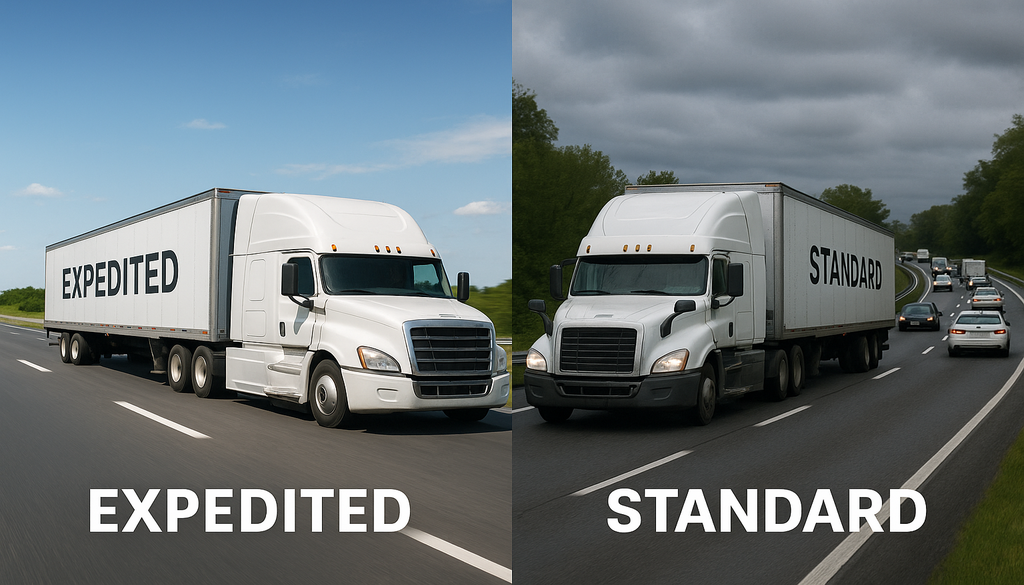
What is Expedited Shipping and Why is it Crucial for 3PLs?
Expedited shipping refers to the accelerated transportation of goods that prioritizes speed over standard delivery timeframes, often involving premium services designed to ensure packages arrive faster than regular shipping methods. For third-party logistics (3PL) providers, this service tier has transformed from a luxury option to an essential offering as consumer expectations continue to evolve in the digital marketplace. When implemented effectively, expedited shipping typically reduces standard delivery windows by 1-3 days, depending on distance and service level, making it a valuable tool for time-sensitive shipments. The significance of expedited shipping has grown exponentially with the rise of e-commerce giants setting new standards for rapid fulfillment, effectively resetting consumer expectations across all retail channels.
The growing importance of expedited shipping directly correlates with changing consumer behavior patterns that now demand near-immediate gratification after purchase. According to recent industry studies, approximately 80% of online shoppers consider delivery speed when making purchasing decisions, with over 60% abandoning carts when shipping options are too slow or inflexible. This shift in consumer psychology has placed tremendous pressure on retailers who, in turn, transfer these expectations to their 3PL partners. For logistics providers, the ability to offer reliable expedited shipping options has become less about competitive advantage and more about market survival, as clients increasingly select logistics partners based on their ability to meet stringent delivery timelines rather than solely on cost considerations.
For 3PLs specifically, expedited shipping capabilities represent a critical service differentiator in an increasingly competitive marketplace. The ability to guarantee faster delivery timeframes allows logistics providers to serve industries with time-critical needs, such as healthcare, automotive parts, and perishable goods. By developing robust expedited shipping solutions, 3PLs can expand their client base while increasing revenue through premium service offerings that command higher margins than standard shipping services. Additionally, mastering expedited logistics enables 3PLs to build stronger relationships with existing clients by demonstrating flexibility and responsiveness to changing market demands or supply chain disruptions.
The Impact of Expedited Shipping on Delivery Speed
The implementation of expedited shipping services significantly transforms delivery performance metrics across supply chains, with most 3PLs reporting 30-50% reductions in transit times compared to standard shipping options. This dramatic improvement stems from several operational adjustments, including prioritized handling, dedicated transportation assets, and optimized routing systems designed specifically for time-sensitive shipments. The cumulative effect of these specialized processes creates a streamlined delivery pathway that bypasses many of the usual bottlenecks encountered in traditional shipping channels. For example, while standard ground shipments might undergo consolidation at multiple distribution points to maximize load efficiency, expedited shipments typically follow more direct routes with fewer stops, substantially reducing the overall transit time and minimizing handling-related delays that could compromise delivery windows.
Real-world applications of expedited shipping demonstrate its tangible impact on business operations. Major 3PL provider XPO Logistics reported that their implementation of advanced expedited services resulted in a 42% improvement in on-time delivery performance for urgent medical supplies during the pandemic, showcasing the critical nature of these services. Similarly, C.H. Robinson’s case studies revealed that clients utilizing their expedited transportation solutions experienced a 35% reduction in supply chain disruptions and a 28% decrease in inventory holding costs due to more reliable delivery timeframes. These operational improvements translate directly to enhanced customer satisfaction, with companies implementing expedited shipping options reporting 15-20% higher customer retention rates compared to competitors offering only standard shipping alternatives.
The technical architecture supporting expedited shipping involves sophisticated optimization algorithms that continuously analyze multiple variables to determine the most efficient routing options. Advanced transportation management systems (TMS) employed by leading 3PLs can instantaneously evaluate thousands of potential combinations of carriers, routes, and transportation modes to identify the optimal solution for each expedited shipment. These systems factor in real-time data points including traffic patterns, weather conditions, carrier performance metrics, and facility processing capacities to make dynamic routing decisions that maintain delivery integrity. Additionally, many sophisticated 3PLs have developed proprietary scoring models that evaluate and rank the reliability of various expedited service options based on historical performance, ensuring that time-critical shipments are consistently assigned to the most dependable transportation channels.
Comparing Shipping Options: Expedited vs. Standard Shipping
Standard shipping typically operates on predetermined schedules with delivery windows ranging from 5-7 business days for domestic shipments and 2-4 weeks for international consignments, prioritizing cost efficiency over speed. This traditional approach follows established transportation networks with regular consolidation of shipments to maximize load capacity and minimize per-unit shipping costs. Conversely, expedited shipping fundamentally restructures these priorities, offering guaranteed delivery within 1-3 business days domestically and 3-5 days internationally by employing dedicated transportation resources, prioritized handling at sorting facilities, and continuous movement through the supply chain. This fundamental difference in operational philosophy extends beyond mere delivery timeframes to encompass the entire approach to shipment handling, resource allocation, and performance measurement within the logistics network.
The benefits of expedited shipping extend beyond the obvious advantage of faster delivery times to include several operational and strategic advantages for both 3PLs and their clients. Reduced transit times directly translate to lower inventory carrying costs, as businesses can maintain leaner inventory levels when replenishment cycles are shortened and more reliable. Additionally, expedited shipping provides enhanced shipment visibility and tracking capabilities, with most premium services offering real-time location updates and proactive status notifications that standard shipping options rarely match. For industries dealing with time-sensitive or high-value products, these tracking capabilities represent a crucial risk management tool that justifies the premium pricing structure of expedited services.
The financial implications of choosing expedited shipping present both challenges and opportunities for 3PLs and their clients. Premium expedited services typically command rates 30-70% higher than standard shipping options, reflecting the additional resources and prioritized handling required to guarantee faster delivery. This cost differential necessitates careful evaluation of each shipment’s time-sensitivity and business impact before selecting expedited options. However, when analyzed comprehensively, many businesses find that the total cost of ownership actually favors expedited shipping for certain product categories when factors such as inventory carrying costs, stockout penalties, and customer satisfaction metrics are incorporated into the calculation. Sophisticated 3PLs have developed decision-support tools that help clients apply this holistic cost analysis to shipping decisions, identifying specific scenarios where expedited shipping delivers superior overall value despite the higher upfront transportation expense.
How 3PLs Can Implement Expedited Shipping Effectively
The successful implementation of expedited shipping services begins with a comprehensive assessment of current operational capabilities and infrastructure readiness. Forward-thinking 3PLs should conduct thorough evaluations of their warehouse management systems, transportation management platforms, and physical distribution networks to identify potential bottlenecks that could compromise expedited delivery performance. This assessment phase typically involves analyzing historical order patterns to determine peak volume periods, evaluating existing carrier relationships for expedited service capabilities, and examining warehouse layouts for potential reconfiguration to support faster picking and processing of urgent shipments. The most successful implementations establish dedicated expedited shipping zones within fulfillment centers, ensuring that time-sensitive orders receive prioritized handling from receipt through delivery without competing with standard shipments for resources or attention.
Developing strategic carrier partnerships represents a critical success factor for 3PLs implementing expedited shipping services. Rather than simply purchasing faster shipping services at market rates, leading logistics providers establish formalized partnerships with specialized carriers that include performance guarantees, dedicated capacity commitments, and priority access during peak periods. These arrangements frequently involve contractual service level agreements (SLAs) with financial penalties for missed delivery windows, ensuring accountability throughout the transportation network. Effective 3PLs typically cultivate relationships with multiple expedited carriers across different service tiers and geographic regions, creating a diversified network that enables them to maintain service continuity even during carrier disruptions or capacity constraints. This multi-carrier strategy also allows 3PLs to optimize expedited shipping costs by matching specific shipment requirements with the most cost-effective carrier option that still meets delivery requirements.
The technological foundation supporting expedited shipping operations must provide seamless integration between order management, warehouse execution, and transportation systems to maintain visibility and control throughout the fulfillment process. Leading 3PLs invest in advanced transportation management systems that incorporate real-time decision support capabilities, automatically evaluating each shipment against multiple expedited service options to identify the optimal balance between cost and delivery performance. These platforms typically include sophisticated rate shopping functionality that considers not only published carrier rates but also negotiated discounts, fuel surcharges, and accessorial fees to determine the true cost of each expedited shipping option. Additionally, implementation of automated exception management tools enables proactive identification and resolution of potential delivery disruptions before they impact customer delivery expectations, an essential capability for maintaining the service reliability that expedited shipping clients demand.
Managing Client Expectations with Expedited Shipping
Effective communication represents the cornerstone of successful client relationship management in expedited shipping scenarios, requiring 3PLs to establish transparent dialogue about service capabilities, limitations, and potential challenges. Implementing a structured onboarding process for expedited shipping clients allows logistics providers to clearly articulate available service levels, geographic coverage limitations, and specific cutoff times that impact next-day or second-day delivery capabilities. Progressive 3PLs develop comprehensive service level guides that outline exactly what clients can expect from each expedited shipping option, including guaranteed delivery windows, tracking capabilities, and exception handling procedures. This documentation should be complemented by regular client education sessions that explain how various factors such as weather events, customs clearance requirements, or regional carrier limitations might impact expedited service performance in specific situations, helping clients develop realistic expectations about what expedited shipping can and cannot accomplish.
Setting realistic expectations begins with precise definition of what constitutes “on-time delivery” for each expedited service tier, eliminating ambiguity that often leads to client dissatisfaction. Instead of generic promises like “fast delivery,” successful 3PLs establish specific, measurable delivery windows for each service level (e.g., “delivery by 10:30 AM next business day” rather than simply “next-day delivery”). This precision extends to proactive communication protocols that keep clients informed throughout the shipping process, particularly when potential delays arise. Leading logistics providers implement automated notification systems that alert clients to potential delivery exceptions within minutes of identification, providing updated delivery estimates and alternative options when available. This approach transforms potential service failures into opportunities to demonstrate problem-solving capabilities, often resulting in stronger client relationships despite occasional delivery challenges.
Future Trends in Expedited Shipping for Logistics
The evolution of expedited shipping will be significantly influenced by advancements in autonomous transportation technologies, with self-driving vehicles and drone delivery systems poised to reshape delivery timeframes and geographical accessibility. Industry projections suggest that autonomous delivery vehicles could reduce expedited shipping costs by 30-40% while simultaneously improving delivery reliability through elimination of driver hour restrictions and human error factors. Similarly, drone delivery systems are rapidly progressing beyond experimental stages, with major logistics providers conducting extensive pilot programs in urban and suburban environments. These aerial delivery systems promise to revolutionize same-day delivery capabilities by bypassing ground transportation congestion entirely, potentially reducing delivery times for urgent packages from hours to minutes in compatible environments. For forward-thinking 3PLs, establishing early partnerships with autonomous technology providers represents a strategic opportunity to secure competitive advantage as these systems move toward mainstream implementation over the next 3-5 years.
The integration of artificial intelligence and predictive analytics into expedited logistics operations promises to transform reactive shipping processes into proactive delivery optimization systems. Advanced algorithms can now analyze historical shipping data, current order patterns, and external factors such as weather conditions and traffic patterns to anticipate delivery challenges before they materialize. This predictive capability enables 3PLs to automatically reroute expedited shipments away from potential bottlenecks, adjust staffing levels to accommodate anticipated volume surges, and proactively communicate with clients about potential delivery adjustments. The most sophisticated implementations of these technologies incorporate machine learning capabilities that continuously improve prediction accuracy through analysis of actual outcomes versus forecasted scenarios, creating a self-optimizing logistics network that becomes increasingly effective at maintaining expedited delivery performance despite external disruptions.
Environmental sustainability considerations will increasingly influence expedited shipping strategies as both regulatory pressures and client expectations evolve toward greater emphasis on carbon footprint reduction. This shift presents both challenges and opportunities for 3PLs, necessitating careful balancing of speed requirements with environmental impact concerns. Leading logistics providers are addressing this tension through investment in alternative fuel vehicles for expedited transportation, optimization of route planning to minimize empty miles, and development of innovative packaging solutions that reduce dimensional weight without compromising product protection. Some progressive 3PLs have begun offering “green expedited” service options that utilize carbon offset programs to neutralize the environmental impact of faster shipping methods, appealing to environmentally conscious clients who require both speed and sustainability. As regulatory frameworks increasingly incorporate carbon pricing mechanisms, the ability to deliver expedited shipping with minimal environmental impact will likely transition from competitive advantage to business necessity for logistics providers serving environmentally progressive markets.
Conclusion
Expedited shipping has emerged as a fundamental capability that defines the modern 3PL service offering, directly impacting client satisfaction, retention, and competitive positioning in today’s speed-focused marketplace. The strategic implementation of expedited shipping solutions enables logistics providers to serve high-value market segments that prioritize delivery speed and reliability over cost considerations, potentially transforming their business models and revenue structures. As we’ve explored throughout this analysis, successful expedited shipping programs require thoughtful integration of specialized operational processes, strategic carrier partnerships, and advanced technological solutions that work in concert to compress delivery timeframes without sacrificing reliability or visibility.
For 3PL executives evaluating their expedited shipping capabilities, the path forward requires honest assessment of current performance against market expectations and systematic addressing of identified gaps. This may necessitate significant investments in technology infrastructure, carrier relationship development, or operational redesign to create truly differentiated expedited service offerings. However, these investments typically deliver substantial returns through enhanced client loyalty, access to premium service markets, and the ability to command higher margins than standard shipping services provide. As consumer expectations continue to evolve toward ever-faster delivery timeframes, the competitive advantage will increasingly belong to 3PLs that can consistently deliver reliable expedited shipping experiences across diverse product categories and geographical regions.
Frequently Asked Questions (FAQ)
Q1: What are the key benefits of expedited shipping for 3PL companies?
Expedited shipping offers several advantages for 3PL providers, including reduced transit times, enhanced customer satisfaction, and the ability to meet tight delivery schedules. By prioritizing speed, 3PLs can improve their service offerings, attract more clients, and maintain a competitive edge in the logistics industry. Implementing expedited shipping also helps in managing supply chain disruptions more effectively, ensuring that client expectations are consistently met even under challenging conditions. Additionally, expedited shipping services typically command premium pricing, allowing 3PLs to increase profit margins while serving time-sensitive market segments that standard shipping providers cannot adequately address. This service differentiation often leads to stronger client relationships and higher retention rates, as businesses increasingly value logistics partners who can reliably deliver time-critical shipments.
Q2: How can 3PLs balance the costs and benefits of expedited shipping?
Balancing the costs and benefits of expedited shipping involves strategic planning and client communication. 3PLs should analyze the demand patterns, evaluate the urgency of shipments, and choose expedited services for critical deliveries. Transparent pricing models and explaining the value of fast delivery to clients can also help in justifying the higher costs associated with expedited shipping. Additionally, leveraging technology to optimize routes and streamline operations can reduce overall expenses while maintaining high service levels. Successful 3PLs typically implement tiered expedited service offerings that allow clients to select the precise balance of speed and cost that aligns with their business requirements for each shipment. This approach, combined with sophisticated analytics that help identify which products and clients benefit most from expedited options, ensures that premium shipping services are deployed where they create maximum value rather than unnecessarily increasing logistics costs across all shipments.





